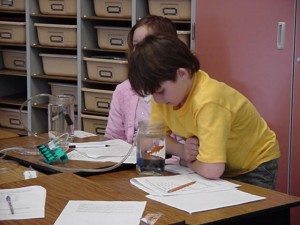
Studying salmon, counting gulps, with support from the San Juan Nature Institute . A fundraising barbecue will be held at the home of Jim and Kathy Youngren on Sept. 30.
From Fiona Norris, San Juan Nature Institute
At 3:30 on Sunday September 30, San Juan Nature Institute will hold a fundraiser for their Salmon in the Classroom program at Orcas Elementary School.
For the third year, Jim and Kathy Youngren have allowed us to organize this at their home at 1649 Olga Road, Orcas. Barbecued salmon and sausages will be served with salad and followed by dessert. The cost is $25 per person (or $60 for a family of four). Reservations for the picnic can be made on line at www.sjnature.org or by calling 378-3646.
All proceeds will support the program and fund 8 lessons by San Juan Nature Institute staff. These will include an experiment to determine the effect of temperature on availability of dissolved oxygen (illustration attached), a project developed by the Friday Harbor Labs Science Outreach program, one of our education partners.
Before dining, guests will have a conducted tour of the Glenwood Hatchery culminating in a visit to the fish ladder where hundreds of Chinook are returning to their home stream. It has been a very good year and we hope that parents and friends of the Fourth Grade Class will join us on Sunday between 3:30 and 5:30 p.m. to enjoy the spectacle, and the feast. Of course if you are not able to come, we would be delighted to accept a donation!
San Juan Nature Institute has been an active partner in Orcas Schools for the past seven years and is eager to continue this program. We are a non-profit, 501(c )(3) organization dedicated to increasing public appreciation and awareness of the incomparable natural history of the archipelago. Our school partnerships are one of four core programs reaching learners of all ages. We are grateful to the Youngrens for their generosity in supporting our efforts in the fourth grade classroom.
Fourth Grade students engaged in counting how fast a goldfish breathes as an indicator of available dissolved oxygen.
**If you are reading theOrcasonian for free, thank your fellow islanders. If you would like to support theOrcasonian CLICK HERE to set your modestly-priced, voluntary subscription. Otherwise, no worries; we’re happy to share with you.**







